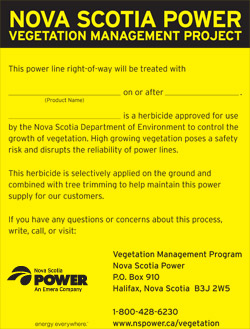- Average annual tree trimming investment: $307,288 (2018-2023)
- Kilometers of distribution lines covered: 60 km (2018-2023)
Vegetation Management
Vegetation Management
Trees make our province a beautiful place to live, but when left unmanaged, they can interfere with power lines and cause outages.
Tree contacts—typically caused by severe weather—are the single largest cause of power outages in Nova Scotia. That’s why our vegetation management program is so important.
You’ve asked us to how we decided when and where to trim and the difference in our approach to vegetation management in rural versus urban settings. Foresters Colton and Peter are here to show you in this video.
Tree Trimming in your community
On average, we invest nearly $200 million across the province each year on reliability. This includes investments in more robust equipment, maintenance, and tree trimming. In 2023, we invested about $32 million in vegetation management and this has increased to almost $45 million in 2024.
Click on your county to learn about how we’ve invested in tree trimming in your area over the last five years.
- Average annual tree trimming investment: $374,894 (2018-2023)
- Kilometers of distribution lines covered: 51 km (2018-2023)
- Average annual tree trimming investment: $613,284 (2018-2023)
- Kilometers of distribution lines covered: 110 km (2018-2023)
- Average annual tree trimming investment: $1,197,787 (2018-2023)
- Kilometers of distribution lines covered: 222 km (2018-2023)
- Average annual tree trimming investment: $306,061 (2018-2023)
- Kilometers of distribution lines covered: 51 km (2018-2023)
- Average annual tree trimming investment: $1,672,851 (2018-2023)
- Kilometers of distribution lines covered: 306 km (2018-2023)
- Average annual tree trimming investment: $673,327(2018-2023)
- Kilometers of distribution lines covered: 132 km (2018-2023)
- Average annual tree trimming investment: $1,150,787 (2018-2023)
- Kilometers of distribution lines covered: 213 km (2018-2023)
- Average annual tree trimming investment: $258,660 (2018-2023)
- Kilometers of distribution lines covered: 48 km (2018-2023)
- Average annual tree trimming investment: $494,430 (2018-2023)
- Kilometers of distribution lines covered: 97 km (2018-2023)
- Average annual tree trimming investment: $1,115,904 (2018-2023)
- Kilometers of distribution lines covered: 193 km (2018-2023)
- Average annual tree trimming investment: $271,652 (2018-2023)
- Kilometers of distribution lines covered: 45 km (2018-2023)
- Average annual tree trimming investment: $1,227,718 (2018-2023)
- Kilometers of distribution lines covered: 208 km (2018-2023)
- Average annual tree trimming investment: $868,510(2018-2023)
- Kilometers of distribution lines covered: 157 km (2018-2023)
- Average annual tree trimming investment: $629,222 (2018-2023)
- Kilometers of distribution lines covered: 121 km (2018-2023)
- Average annual tree trimming investment: $1,652,688 (2018-2023)
- Kilometers of distribution lines covered: 279 km (2018-2023)
- Average annual tree trimming investment: $2,120,198 (2018-2023)
- Kilometers of distribution lines covered: 362 km (2018-2023)
- Average annual tree trimming investment: $332,150 (2018-2023)
- Kilometers of distribution lines covered: 65 km (2018-2023)
About our vegetation management program
As part of this work, we often require permission from customers to complete work on private property. Every time you grant us permission to complete vegetation management on your property, it helps in preventing outages for your community.
Our electrical system is made up of over 32,000 kilometres of power lines—the majority of which run along forested areas and tree lined roads. Each year, our vegetation management team identifies work areas throughout the province. Our crews and contractors trim right-of-way paths to ensure power lines are clear of trees and brushes.
We use a combination of methods to trim and prevent trees from growing near power lines. Options in rural areas include manually trimming tree branches and other higher growing vegetation near the power lines, removing trees in the right-of-way, and where possible, applying herbicides on shorter trees and stumps to restrict tree regrowth.
Aerial Trimming of Trees
Qualified utility workers use bucket trucks to prune branches that are too close to energized equipment. We direct remaining growth away from the wires to prevent trees from growing into the power line.
Mechanical Clearing
At sites with tree regrowth, mowers are used to clear the site and open space for shrubs to grow.
Manual Clearing
Areas are selectively cut with chainsaws and brush saws to ensure only tree growth is removed. We also use this method around streams to ensure some tree and shrub growth is left to provide shade and cover for wildlife.
Herbicides have been widely used for years to safely manage vegetation growth and are more effective than only cutting trees. Cutting hardwood trees leads to quick regrowth of new tree sprouts from the stump, interfering with the growth of low-lying shrubs, and requiring our crews to return more often to the area for maintenance. Herbicide application effectively prevents this regrowth, thus promoting the growth of lower-growing plants like grasses, shrubs, ferns, and berries that do not interfere with power lines. The herbicide most often used by our forestry crews is Garlon XRT, which is registered for use by the Pest Management Regulatory Agency (PMRA) of Health Canada.
Permission, Public Notice, and Water Protection
Herbicide use is regulated through an approval from the provincial government. Prior to any application, Nova Scotia Power submits project maps to the Nova Scotia Department of Environment and Climate Change. All approvals require a buffer from watercourses and from private water supplies. Nova Scotia Power publicly advertises for at least 20 days prior to any work beginning and posts street-level notification on site at least seven days prior to any herbicide application.

Frequently Asked Questions
There’s a lot that goes into deciding where and when to trim trees that are near our lines.
We prioritize based on the proximity of trees to our power lines, and we look at outage data to better understand where we’re seeing the most outages caused by trees. We also consider the condition of our lines through assessments by our forestry teams and requests that come from you, our customers.
It’s important to note that we can’t always trim every tree that are a risk to our lines. These trees are often on private property, so we need to work with municipalities, communities and individual landowners to gain permission and access to trim trees on their properties.
We typically can only cut 10 ft on the forest side of the powerlines. Getting permission to trim trees any beyond the 10 ft is paramount to us improving reliability.
When you make a request for a tree to be trimmed through our tree trimming program, it must meet certain criteria. If the tree is deemed to not be a threat to our infrastructure, it may be your responsibly, or a third party’s responsibility to remove or manage the tree. To learn more about responsibilities of different parties, click here.
Any emergency situations, like fallen branches that have resulted in downed wires require our immediate attention. Downed wires are high voltage and dangerous. If you see a wire that poses a threat to you or your community’s safety, please contact us directly at 1-800-428-6230.
We trim trees and branches along approximately 1,000 km of powerlines annually. That’s about the same distance from Halifax to Quebec City.
Tree contacts are the single largest cause of power outages in Nova Scotia. Because severe weather typically causes tree damage and outages, we target hard-hit areas after each storm by trimming more trees and removing weakened branches that may cause problems later. For example, in the weeks and months following Fiona, we addressed 5,000 areas that had tree damages that could have caused outages in the future.
Going forward, our plans will include increasing our tree trimming investment year over year and nearly doubling our annual investment over the next five years to continue to improve reliability.
Our team only removes trees that we need to. We leave tree species like Alder trees in places where they'll never grow high enough to pose a threat to our powerlines.
Both Nova Scotia Power and the Halifax Regional Municipality (HRM) are responsible for tree trimming within HRM.
HRM manages the tree trimming on all municipality owned trees (typically the trees between sidewalks and the roadway), and we manage the trimming on all privately-owned trees that may pose a risk to our electrical system. This includes any trees that are close to high voltage wires, or any branches that are laying on our lines, or causing damage to our equipment. It's important to note that before trimming on private property, we first need the customer's permission.
Customers are responsible for trimming around the low voltage wire that runs along the street to your home, communications wires, and the support cables that provide physical support to our poles.
For more information on tree-trimming responsibility and submitting a request, visit this page.
Our vegetation management team is made up of highly trained forestry professionals and technicians. This team is experienced in assessing what trees pose potential hazards, based on species, tree health or ground conditions.
On any given day, we have anywhere from 50 to 60 contractor crews trimming trees across Nova Scotia. You’ll often see Asplundh, Lucas Tree Experts or R MacLean Forestry vehicles completing this work.
Our power line technicians are also trained in some aspects of forestry work and may need to trim trees as part of a response to an outage.
MORE Questions for us?
Our forestry team responds to any questions or concerns about vegetation management activities and can be reached through our Customer Care Centre.



